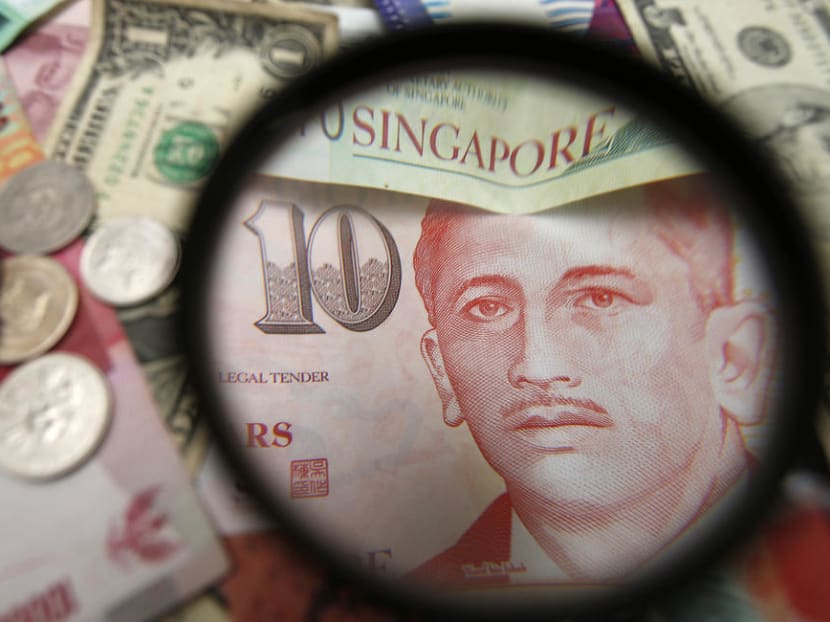Explainer: Amid Covid-19 outbreak, what MAS' unprecedented monetary policy easing means
SINGAPORE — For the first time, the Monetary Authority of Singapore (MAS) made a double move to ease its monetary policy: First by gentling the slope of the policy band within which the Singapore dollar moves to a zero rate of appreciation, and then lowering the midpoint of the band.

The Monetary Authority of Singapore flattened the policy band to a neutral stance, which shows that it does not want the Singdollar to strengthen against other currencies. It also lowered the band’s midpoint to weaken the Singdollar’s exchange rate.
SINGAPORE — For the first time, the Monetary Authority of Singapore (MAS) made a double move to ease its monetary policy: First by gentling the slope of the policy band within which the Singapore dollar moves to a zero rate of appreciation, and then lowering the midpoint of the band.
The moves came as no surprise to economists as several had expected Singapore’s central bank to take drastic monetary policy action in view of the huge impact the Covid-19 pandemic has had on its trade-reliant economy.
In its monetary policy statement on Monday (March 30), MAS twice made reference to how Singapore will be going into recession, adding that there is “significant uncertainty over the depth and duration of this recession”.
The Trade and Industry Ministry had forecast Singapore’s economy to contract by between 4 and 1 per cent for 2020.
Inflation forecasts have also been lowered, as MAS expects core inflation, which excludes the cost of accommodation and private road transport, to come in at -1 per cent, while overall inflation is projected to remain flat for 2020.
TODAY explains what the policy moves by MAS mean and what impact it would have on Singapore's economy.
THE THREE POLICY LEVERS
The main role of a country’s central bank is to maintain price stability, and it is the same for MAS.
It manages monetary policy through exchange rate settings, rather than through interest rates as other central banks do, letting the Singapore dollar rise or fall against the currencies of its main trading partners within an undisclosed policy band, known as the Singapore dollar nominal effective exchange rate or S$NEER.
The Singdollar is allowed to appreciate or depreciate against this basket of currencies, as long as it stays within this band.
MAS uses three policy levers when making adjustments to its monetary policy: By changing the slope of the band, by lowering or raising the midpoint of the band, or by widening or narrowing the upper and lower limits of the band.
WHAT DOES IT MEAN TO EASE MONETARY POLICY?
Given the weak economic outlook and falling prices of goods and services, central banks would typically choose to ease monetary policy to drive growth.
In MAS’ case, an easing would involve gentling the slope of the band and lowering its midpoint.
This time, MAS flattened the band to a neutral stance, which shows that it does not want the Singdollar to strengthen against other currencies. It also lowered the band’s midpoint to weaken the Singdollar’s exchange rate.
In most of MAS’ bi-annual policy reviews, it made adjustments by moving the gradient of the slope. The central bank’s move to lower the policy band on Monday is the first time it has done so since the 2009 global financial crisis.
It is also the first time MAS made both adjustments in the same review.
The lowering of the band would give the Singdollar a greater degree of freedom to weaken even further if the recession turns out to be deeper than expected, said Maybank Kim Eng economist Chua Hak Bin.
“It moves the exchange rate to a more competitive level and cushions the economy,” he added.
WHY THE NEED FOR A WEAKER SINGAPORE DOLLAR?
Economists explained that a weaker Singdollar would typically help boost Singapore’s export-oriented sectors, as this means that goods sold overseas would be cheaper and more attractive to overseas markets.
However, some said the weaker Singdollar this time would have no real impact in terms of helping companies boost their exports, or making it cheaper for tourists to come to Singapore.
Firstly, Singapore has all but closed its borders and global demand for exports has also dropped drastically.
Secondly, Singapore’s move to weaken its currency comes amid a global context of weaker currencies globally.
“The monetary policy action won’t deliver what Singapore exporters are hoping for. It is to complement the second stimulus package… and provide an additional buffer for the Singapore economy,” said DBS Bank economist Irvin Seah.
Deputy Prime Minister Heng Swee Keat unveiled a S$48 billion Resilience Budget last week, in addition to the S$6.4 billion support package in his February Budget statement, to help businesses and workers hit hard by the Covid-19 outbreak.
Speaking to reporters on Monday after touring Changi Airport, Mr Heng said that monetary policy cannot reflate Singapore’s economy.
“In fact our aim is not to aim for growth at this point, it is very focused on limiting the damage to the economy and, in particular, not affecting the long-term capability of our workers,” he added.
The real-world impact of MAS’ monetary policy action this time on companies and workers would be muted, said OCBC Bank's head of treasury research and strategy Selena Ling.
“If they didn’t weaken the Singdollar rate, and economic conditions continue to soften and currencies continue to weaken in line with disinflationary pressures, and with more company retrenchments, bankruptcies and liquidations, the currency would not be reflective of current reality,” said Ms Ling.








